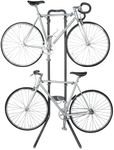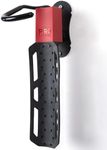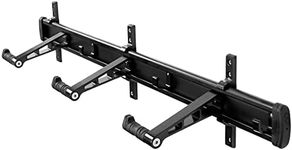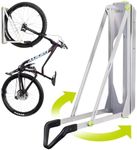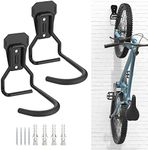Buying Guide for the Best Bike Wall Mounts
Choosing the right bike wall mount is all about making sure your bike is stored safely, conveniently, and in a way that fits your space. The right mount will protect your bike from damage, keep your living area organized, and make it easy to access your bike when you need it. Before you start shopping, think about where you want to hang your bike, how much space you have, and how often you’ll be taking your bike down and putting it back up.Mounting TypeMounting type refers to how the bike wall mount attaches to your wall and how it holds your bike. The main types are horizontal mounts, which hold the bike parallel to the wall, and vertical mounts, which hold the bike perpendicular to the wall. Horizontal mounts are great for saving space in wide rooms and displaying your bike, while vertical mounts are better for narrow spaces or when you want to store more than one bike. Think about your wall space and how you want your bike to be positioned when choosing the mounting type.
Weight CapacityWeight capacity is the maximum weight the wall mount can safely hold. This is important because using a mount that can't support your bike's weight could lead to accidents or damage. Bike wall mounts usually have a range of weight limits, from lighter mounts for road bikes to heavy-duty ones for mountain or electric bikes. Check your bike’s weight and make sure the mount you choose can handle it, with a little extra capacity for safety.
Material and Build QualityMaterial and build quality refer to what the mount is made of and how sturdy it is. Most mounts are made from metal, plastic, or a combination. Metal mounts are generally stronger and more durable, while plastic mounts can be lighter and less expensive. If you have a heavy bike or want a mount that will last a long time, look for strong materials and solid construction. For lighter bikes or temporary setups, lighter materials may be enough.
Ease of InstallationEase of installation is about how simple it is to set up the wall mount. Some mounts require drilling and heavy-duty anchors, while others use simpler hardware. If you’re comfortable with tools and want a permanent solution, a more complex installation might be fine. If you’re renting or want something you can move easily, look for mounts that are easy to install and remove without damaging the wall.
Bike CompatibilityBike compatibility means whether the mount will work with your specific bike’s size, frame shape, and tire width. Some mounts are adjustable and can fit a wide range of bikes, while others are designed for certain types, like road bikes or fat-tire bikes. Check the mount’s specifications and compare them to your bike’s measurements to make sure they’re a good match.
Protection FeaturesProtection features are details that help prevent your bike from getting scratched or damaged while it’s on the mount. These can include rubber or foam padding, hooks with soft covers, or designs that keep the bike from touching the wall. If you care about keeping your bike in top condition, look for mounts with good protection features, especially if your bike has a delicate finish.




